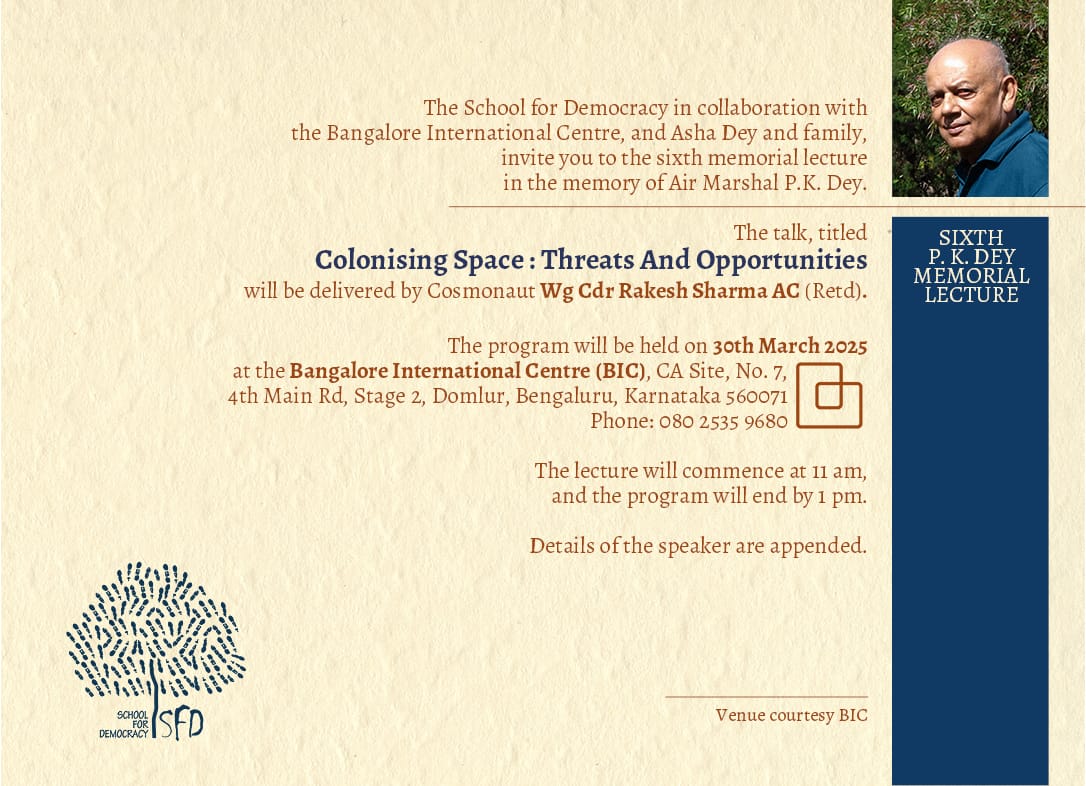My Article Published on the EurasianTimes Website on 30 Mar 25.
Beginning of Mar 25, at the Mobile World Congress (MWC) in Barcelona, Nokia revealed that US defence and aerospace manufacturer Lockheed has deployed Nokia’s 5G solutions into its Hybrid Base Station. According to its website, Lockheed’s HBS is a unified network solution that provides communications, Edge processing, and advanced network capabilities for interoperable, resilient, and secure connectivity and data flow across all domains. Nokia added that its military-grade 5G technology makes it possible to “integrate commercial 5G connections with military communications systems to provide decisive information for national defence,” highlighting the importance of interoperability.
Earlier this year, China claimed to have introduced what it describes as the world’s first mobile 5G base station for military purposes. According to a South China Morning Post report, it was developed in partnership with China Mobile Communications Group and the Chinese People’s Liberation Army (PLA). The reports highlighted that the 5G mobile base station delivers high-speed, low-latency, and secure data services, supporting up to 10,000 users within a 3km radius. The system maintains a consistent total throughput of 10 gigabits per second with latency under 15 milliseconds. The report also stated that this new 5G base station paves the way for the extensive deployment of intelligent war machines. China is currently constructing what it claims to be the world’s most significant unmanned military force, featuring advanced yet cost-effective drones, robotic dogs, and other autonomous combat platforms that could eventually outnumber human soldiers.
Effective communication is essential in military aviation, where split-second decisions can determine a mission’s success or a personnel’s safety. The advent of fifth-generation wireless technology (5G) and advanced communication networks promises to revolutionise this field. With unparalleled speed, low latency, and extensive connectivity, 5G has transformative potential for real-time data sharing among aircraft, command centres, and other platforms. It enhances real-time communications in military aviation, strengthens network-centric warfare for a more integrated air force, and introduces security risks that must be addressed to protect operations. By examining these factors, we can recognise the significant implications of advanced communication technologies for modern military aviation.
Understanding 5G Technology. 5G, the fifth generation of wireless communication technology, is characterised by its high speed, low latency, and capacity to connect many devices simultaneously. These attributes make it a game-changer for military aviation, where timely and reliable communication is critical. Unlike its predecessors, 5G operates on higher frequency bands, such as millimeter waves, providing wider bandwidths for faster data transmission. It also employs techniques like beam forming, directing signals to specific devices rather than broadcasting omnidirectionally, to optimise signal strength and reduce interference.
Military Aviation: Possibilities
In military aviation, real-time data sharing involves the seamless exchange of information between aircraft, command centers, unmanned aerial vehicles (UAVs), and other platforms. 5 G’s speed often exceeds 1 Gbps. Its latency, reduced to as low as 1 millisecond, enables near-instantaneous communication, a stark improvement over 4G’s 20-30 millisecond latency.
Types of Data. Real-time data is crucial in military and defence applications, enhancing situational awareness and operational efficiency. Sensor data from radar, infrared, and other detection systems provide critical intelligence on enemy positions and movements. For instance, a fighter jet detecting a hostile target can instantly transmit its coordinates to allied forces, improving response time. Video feeds, including HD or 4K footage from UAVs or onboard cameras, offer live intelligence, with 5G ensuring seamless transmission to command centers. Telemetry data tracks aircraft speed, altitude, fuel levels, and system health, enabling proactive maintenance and reducing downtime. Communication data, including voice and text transmissions, ensures seamless coordination between pilots, ground crews, and commanders, facilitating synchronised operations. These data types support real-time decision-making, enhancing battlefield effectiveness, reducing risks, and optimising mission success rates. Integrating AI and advanced networks further strengthens these capabilities, making modern military operations more responsive and precise.
Enhancing Data Sharing Across Platforms. In combat scenarios, aircraft must exchange vast amounts of data, radar signatures, sensor readings, high-definition video feeds, and tactical updates with command centers and allied units. Consider a multi-aircraft operation targeting enemy defences: each fighter jet must instantly share its position, target data, and threat assessments. For instance, a reconnaissance plane detecting an enemy convoy could stream live video to a command center, relaying precise coordinates to strike aircraft within moments. This speed enhances decision-making, enabling commanders to adapt strategies dynamically. Moreover, 5G’s low latency is a game-changer for time-sensitive applications. Even a half-second delay could be fatal during air-to-air engagements, where pilots rely on real-time radar and missile lock data. By slashing latency to 1 ms, 5G ensures data arrives when needed, improving coordination and precision.
Integration with Unmanned Systems. Unmanned aerial vehicles (UAVs) and drones are increasingly vital to military operations and performing reconnaissance, strikes, and electronic warfare. These systems depend on robust communication links to receive commands and transmit data. 5G’s high capacity and responsiveness enhance this connectivity. For example, a drone swarm conducting surveillance over hostile territory could send high-resolution imagery back to a command center while receiving real-time updated flight instructions. This capability supports more autonomous and complex UAV missions, such as coordinated attacks or perimeter defence, by maintaining a constant, reliable link. Additionally, 5G’s massive device connectivity allows numerous sensors and platforms to be integrated. A single operation might involve dozens of drones, manned aircraft, and ground stations, all sharing data through a unified network. This scalability ensures the communication infrastructure can keep pace as unmanned systems proliferate, fostering a more versatile and responsive air force.
Network-Centric Joint Warfare. Network-centric warfare (NCW) redefines military operations by linking all elements, aircraft, ground forces, naval units, and command centers into a cohesive information-sharing network. The goal is to achieve a decisive advantage through enhanced situational awareness, coordination, and speed. In aviation, NCW transforms isolated aircraft into nodes within a broader system, amplifying their effectiveness through collective intelligence. With 5G, NCW reaches new heights. Its high-speed, low-latency network enables seamless data exchange across platforms, creating a more integrated air force. Imagine a scenario where a reconnaissance drone identifies a mobile missile launcher. Within seconds, 5G transmits this intelligence to a nearby fighter jet, which adjusts its flight path while informing ground-based air defences and a command center. The jet engages the target, and the updated status is shared network-wide, allowing other units to reposition accordingly. This rapid, synchronised response exemplifies how 5G enhances operational tempo and effectiveness.
Enhancing Situational Awareness. Modern combat aircraft, including fifth- and sixth-generation fighters, rely heavily on seamless communication with command centers, reconnaissance drones, and other allied aircraft. The ability to transmit and receive data in real time enhances situational awareness, allowing pilots to react swiftly to evolving threats.
Optimising Command and Control. Military command centers depend on real-time data feeds to make strategic decisions. 5G networks enable instantaneous transmission of mission-critical information, including radar feeds, target tracking, and intelligence updates. This increased speed and reliability minimises decision-making delays, ensuring that commanders can deploy assets more efficiently and respond dynamically to threats.
AI and Big Data Integration. Advanced communication networks empower artificial intelligence (AI) systems to analyse vast battlefield data in real time. AI-driven analytics can provide predictive insights on enemy movements, optimise flight paths, and suggest strategic manoeuvres to pilots. Fusing AI with 5G networks creates a more innovative, adaptive military force capable of making split-second decisions based on real-time intelligence. This integration allows for the efficient processing of large volumes of data, enabling the military to make informed decisions and respond effectively to changing situations.
Security Risks
Integrating 5G into military aviation offers enhanced communication, real-time data sharing, and improved battlefield awareness. However, it also introduces significant security risks that could compromise mission success. As military systems increasingly rely on wireless, software-driven networks, the attack surface expands, creating new vulnerabilities.
One primary concern is jamming and interference, whereby adversaries employ electronic warfare techniques to disrupt 5G signals, which could sever critical communication links. Cyber attacks pose another serious threat; hackers might manipulate data transmissions, injecting false coordinates into navigation systems, potentially leading to disastrous consequences such as mission failure or friendly fire. Espionage is also a pressing issue, as adversaries could intercept sensitive transmissions, including radar data and flight plans, thereby exposing strategic operations. Furthermore, vulnerabilities in the supply chain emerge due to reliance on commercial 5G infrastructure.
Many private firms involved in 5G deployment may inadvertently introduce security loopholes, whether intentionally or not, granting hostile entities backdoor access. The sheer speed of 5G exacerbates these risks, allowing adversaries to launch large-scale cyber attacks more swiftly than traditional defence mechanisms can react. Additionally, the heavy dependence on virtualisation and software-defined networking introduces software-based vulnerabilities, which, if left unpatched, could be exploited by sophisticated attackers.
EW adds another layer of complexity. Adversaries might target 5G’s millimeter-wave frequencies, which, while offering high bandwidth, are susceptible to interference in contested environments. A successful jamming operation could isolate aircraft from command, crippling NCW’s effectiveness.
Threats to Military Aviation. These risks have dire implications in aviation. A compromised 5G network could disrupt UAV control, causing drones to crash or attack unintended targets. Interrupted communications might allow enemies to anticipate and counter manoeuvres during a coordinated strike. Moreover, reliance on commercial networks shared in 5G deployments raises concerns about espionage, especially if foreign entities dominate the supply chain. For instance, debates over certain manufacturers’ involvement in 5G infrastructure highlight fears of embedded vulnerabilities accessible to rival nations.
Mitigation Strategies.
To address the security risks associated with 5G in military aviation, robust defence mechanisms must be established. Encryption is vital, ensuring that intercepted communications remain indecipherable to adversaries—end-to-end encryption safeguards sensitive data, such as radar feeds and flight plans, from exploitation. Authentication protocols further bolster security by requiring multi-factor authentication to verify user and device identities, thereby preventing unauthorised access. Intrusion detection systems play a crucial role by continuously monitoring network traffic for anomalies, enabling rapid responses to cyber threats before they cause harm. Furthermore, redundancy is essential—backup communication channels, such as satellite links, provide fail-safes during 5G network disruption due to jamming or cyber attacks. Developing dedicated, military-specific 5G networks, distinct from commercial infrastructure, further enhances security by minimising exposure to supply chain risks and potential backdoors. Regular security audits and penetration testing assist in identifying vulnerabilities before adversaries can exploit them. Collaborating with the private sector can also strengthen the security of commercial components used in military applications. Lastly, training personnel to recognise cyber threats and respond effectively ensures that human factors do not become vulnerabilities in cyber security. The military can mitigate 5G-related risks while harnessing its advantages by adopting a comprehensive, multi-layered defence strategy.
Conclusion
The 5G race between China and the United States is more than just a contest for technological supremacy; it is a battle that could redefine the future of aerial warfare. As both nations invest heavily in next-generation networks, integrating 5G into military aviation will enable faster data transmission, enhanced artificial intelligence, and real-time battlefield awareness. This technology has the potential to revolutionise drone warfare, enable seamless coordination between manned and unmanned systems, and improve electronic warfare capabilities. However, the competition is not solely about innovation but security and strategic dominance. The United States remains wary of China’s 5G infrastructure, citing risks of espionage and cyber vulnerabilities, while China continues to push its indigenous advancements to reduce dependence on Western technology. The outcome of this race will not only shape military strategies but also influence global alliances, trade policies, and the future of digital warfare. As the dragon and the eagle vie for control, nations aligning with either power must carefully navigate the geopolitical implications of their technological choices. Ultimately, the side that harnesses 5G most effectively for aerial combat may gain a decisive edge in future conflicts, setting the stage for a new era of warfare.
Please Do Comment.
Link to the Article on the website:-
For regular updates, please register your email here:-
References and credits
To all the online sites and channels.
Pics Courtesy: Internet
Disclaimer:
Information and data included in the blog are for educational & non-commercial purposes only and have been carefully adapted, excerpted, or edited from reliable and accurate sources. All copyrighted material belongs to respective owners and is provided only for wider dissemination.
References:-
- Bertók, P., Salah, K., & Zhuang, W. (2022). “Security Challenges and Countermeasures in 5G Networks for Military Use.” IEEE Access, 10, 49321–49337.
- O’Hanlon, M. (2021). “The Role of Advanced Communications in Future Military Conflicts.” Brookings Institution Report.
- He, Y., & Song, H. (2023). “5G-Enabled Cyber Defence in Military Aviation: Threats and Solutions.” Defence Technology, 19(4), 320-336.
- Weinbaum, C. (2022). “5G and the Battlefield of the Future.” Defence One. www.defenseone.com
- Strout, N. (2023). “How the Pentagon Plans to Secure 5G Networks for Military Use.” C4ISRNET. www.c4isrnet.com
- McLeary, P. (2023). “5G, AI, and the Future of Defense Communications.” Breaking Defence. Retrieved from www.breakingdefense.com
- U.S. Department of Defense. (2020). 5G Strategy Implementation Plan. www.defense.gov
- North Atlantic Treaty Organization (NATO). 5G Technologies in Future Air Combat Systems. NATO Communications and Information Agency (NCIA), 2022.
- Ericsson. (2021). The Role of 5G in Defense and Security Applications. Retrieved from www.ericsson.com
- RAND Corporation. (2023). The Future of 5G in U.S. Military Operations. www.rand.org
- International Air Transport Association (IATA). 5G and Military Aviation: Enabling Next-Generation Communications. IATA Aviation Technology Conference, 2022.
- Air Force Research Laboratory (AFRL). Next-Gen Combat Cloud: How 5G Will Enhance Aerial Combat Systems. AFRL Annual Symposium, 2023.
- European Defence Agency. The Role of 5G in Military Communication Networks. EDA Technical Report, 2021.
- Erwin, Sandra. “How 5G Could Revolutionize Air Combat Networks.” SpaceNews, 15 August 2021.
- Mehta, Aaron. “5G and the Future of Military Aviation: The Risks and Benefits.” Breaking Defense, 10 November 2022.
- Gao, Charlie. “The Air Force’s 5G Ambitions: A Faster, Smarter, and More Connected Force.” The National Interest, 5 January 2023.




